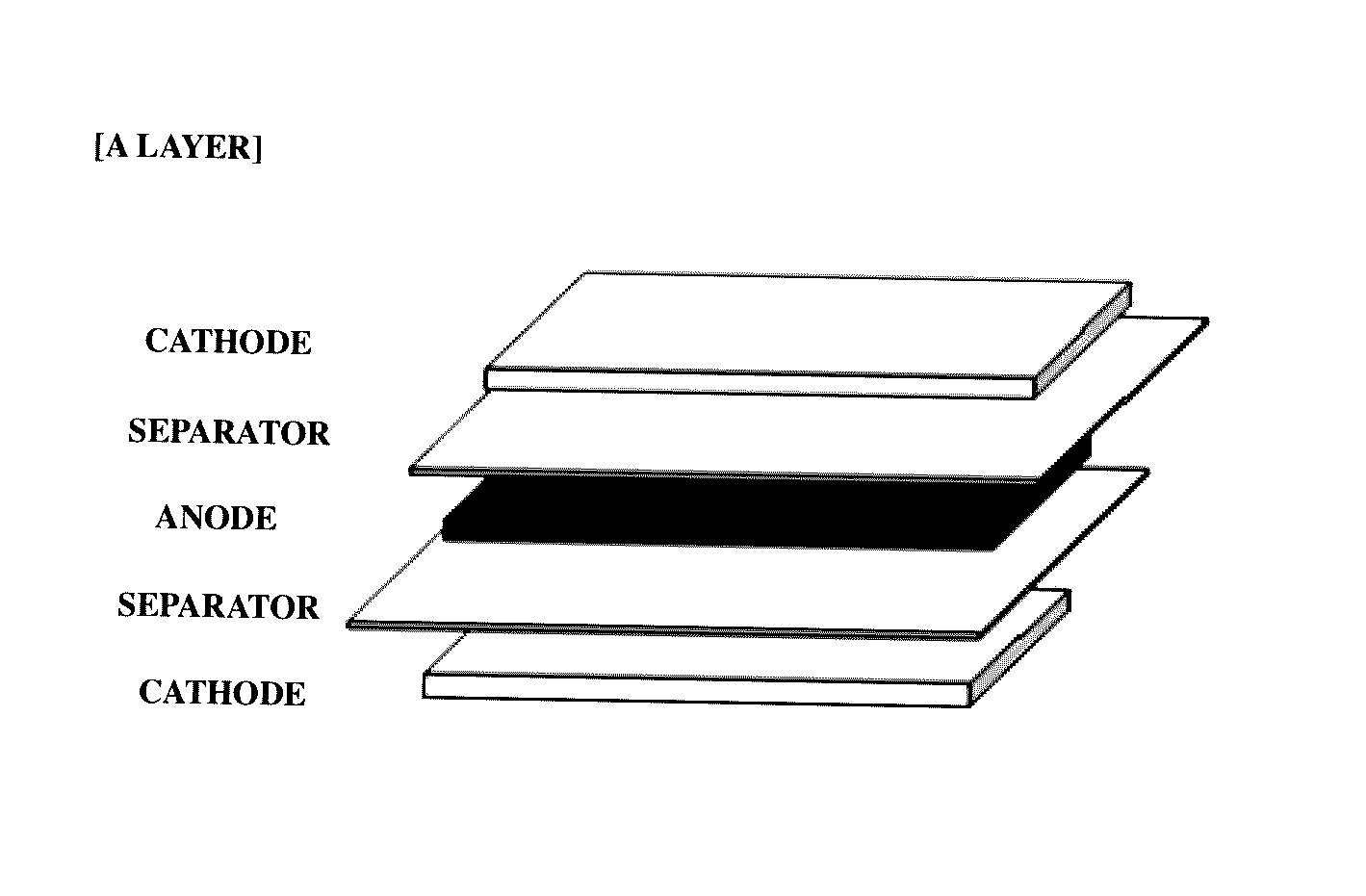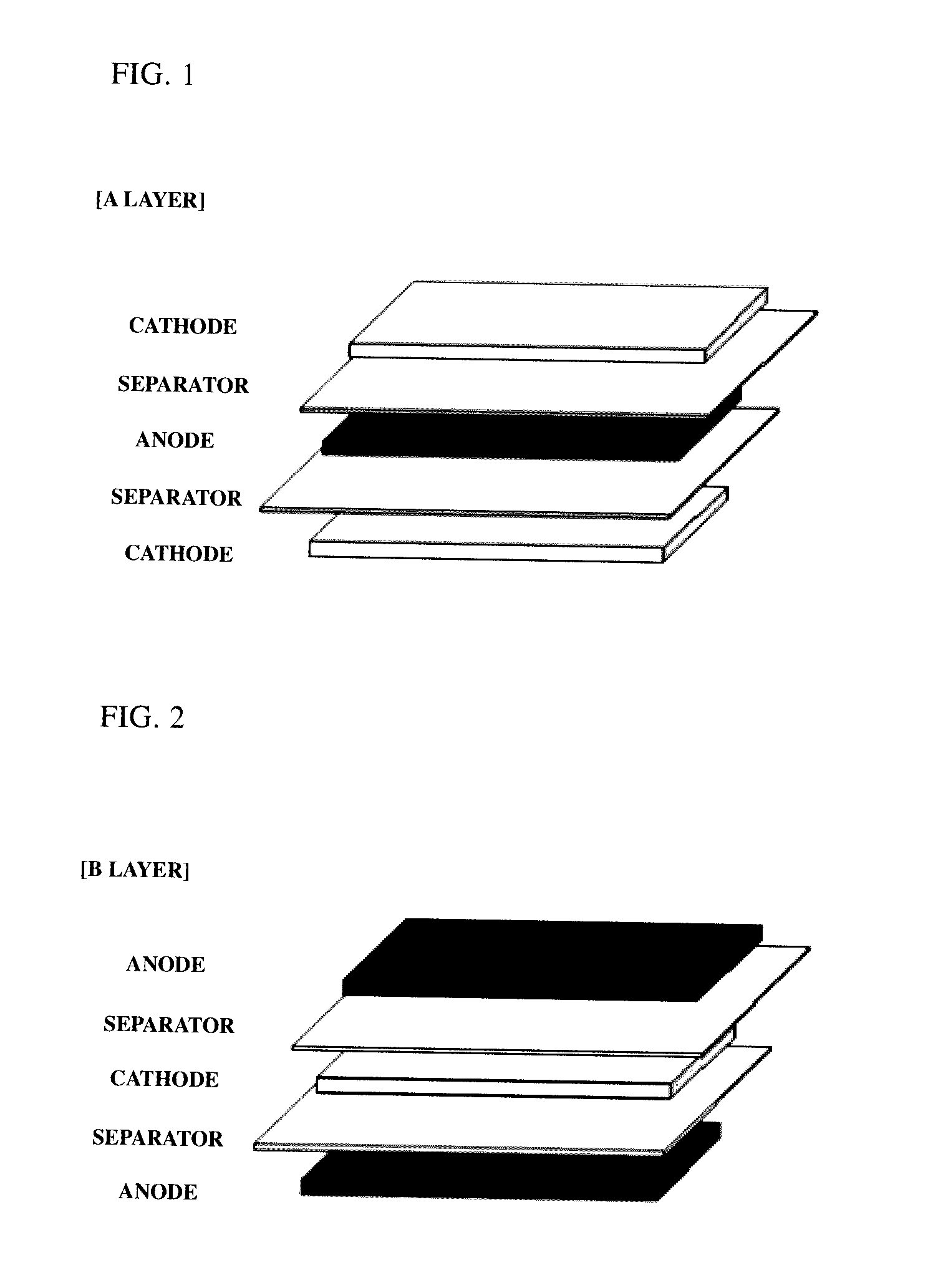Lithium secondary battery with excellent performance
a secondary battery and excellent technology, applied in the direction of batteries, wound/folded electrode electrodes, sustainable manufacturing/processing, etc., can solve the problems of human body, difficult to synthesize, disadvantageous economic efficiency of licoo/sub>2
- Summary
- Abstract
- Description
- Claims
- Application Information
AI Technical Summary
Benefits of technology
Problems solved by technology
Method used
Image
Examples
example 1
[0070]Li1.33Ti1.67O4 as an anode active material, Denka black as a conductive material, and PVdF as a binder were added in a weight ratio of 90:5:5 to NMP and mixed therein to prepare an anode mixture. Subsequently, the anode mixture was coated onto 20 μm Al foil and the coated Al foil was pressed and dried, thereby completing fabrication of an anode.
[0071]In addition, LiNi0.5Mn1.5O4 as a cathode active material, Denka black as a conductive material, and PVdF as a binder was added in a weight ratio of 90:5:5 to NMP and mixed therein to prepare a cathode mixture. Subsequently, the cathode mixture was coated onto 20 μm Al foil and the coated Al foil was pressed and dried, thereby completing fabrication of a cathode.
[0072]By interposing separators (thickness: 20 μm) between the prepared cathodes and anodes, a plurality of A-type bicells (see FIG. 1) having a unit stacked structure of cathode / separator / anode / separator / cathode and a plurality of C-type bicells having a unit stacked struc...
experimental example 1
[0075]Cut-off voltages of the secondary batteries manufactured according to Example 1 and Comparative Example 1 were set to 3.5 V and anode and cathode potentials of each secondary battery were measured when the cut-off voltage was reached. Results are shown in Table 1 below.
[0076]
TABLE 1Anode potential (V)Cathode potential (V)Example 11.264.76Comparative1.55.0Example 1
[0077]Referring to Table 1, in the secondary battery of Example 1, the potential of the anode is 1.26 V when the cut-off voltage is reached and thus the potential of the cathode is 4.76 V and, accordingly, the potential of the cathode reaches the cut-off voltage before reaching an oxidation potential of an electrolyte. By contrast, in the secondary battery of Comparative Example 1, the potential of the anode is 1.5 V when the cut-off voltage is reached and thus the potential of the cathode is 5.0V and thus reaches an oxidation potential of an electrolyte.
experimental example 2
Evaluation of Lifespan Characteristics of Secondary Battery
[0078]The secondary batteries of Example 1 and Comparative Example 1 were subjected to charging and discharging at 1 C and 600 mA in a range of 2 to 3.35 V. Changes in charge capacity of each battery were measured while 50 charging and discharging cycles were repeated at room temperature. Results are shown in FIG. 4.
[0079]Referring to FIG. 4, the secondary battery of Example 1 exhibits a capacity retention ratio of approximately 77%, while the secondary battery of Comparative Example 1 exhibits a capacity retention ratio of approximately 72%. From the results, it can be confirmed that the battery of Example 1 exhibits less reduction in charge capacity than that of the battery of Comparative Example 1 even when charging and discharging processes are repeated.
PUM
| Property | Measurement | Unit |
|---|---|---|
| charge cut-off voltage | aaaaa | aaaaa |
| charge cut-off voltage | aaaaa | aaaaa |
| charge cut-off voltage | aaaaa | aaaaa |
Abstract
Description
Claims
Application Information
 Login to View More
Login to View More - R&D
- Intellectual Property
- Life Sciences
- Materials
- Tech Scout
- Unparalleled Data Quality
- Higher Quality Content
- 60% Fewer Hallucinations
Browse by: Latest US Patents, China's latest patents, Technical Efficacy Thesaurus, Application Domain, Technology Topic, Popular Technical Reports.
© 2025 PatSnap. All rights reserved.Legal|Privacy policy|Modern Slavery Act Transparency Statement|Sitemap|About US| Contact US: help@patsnap.com



